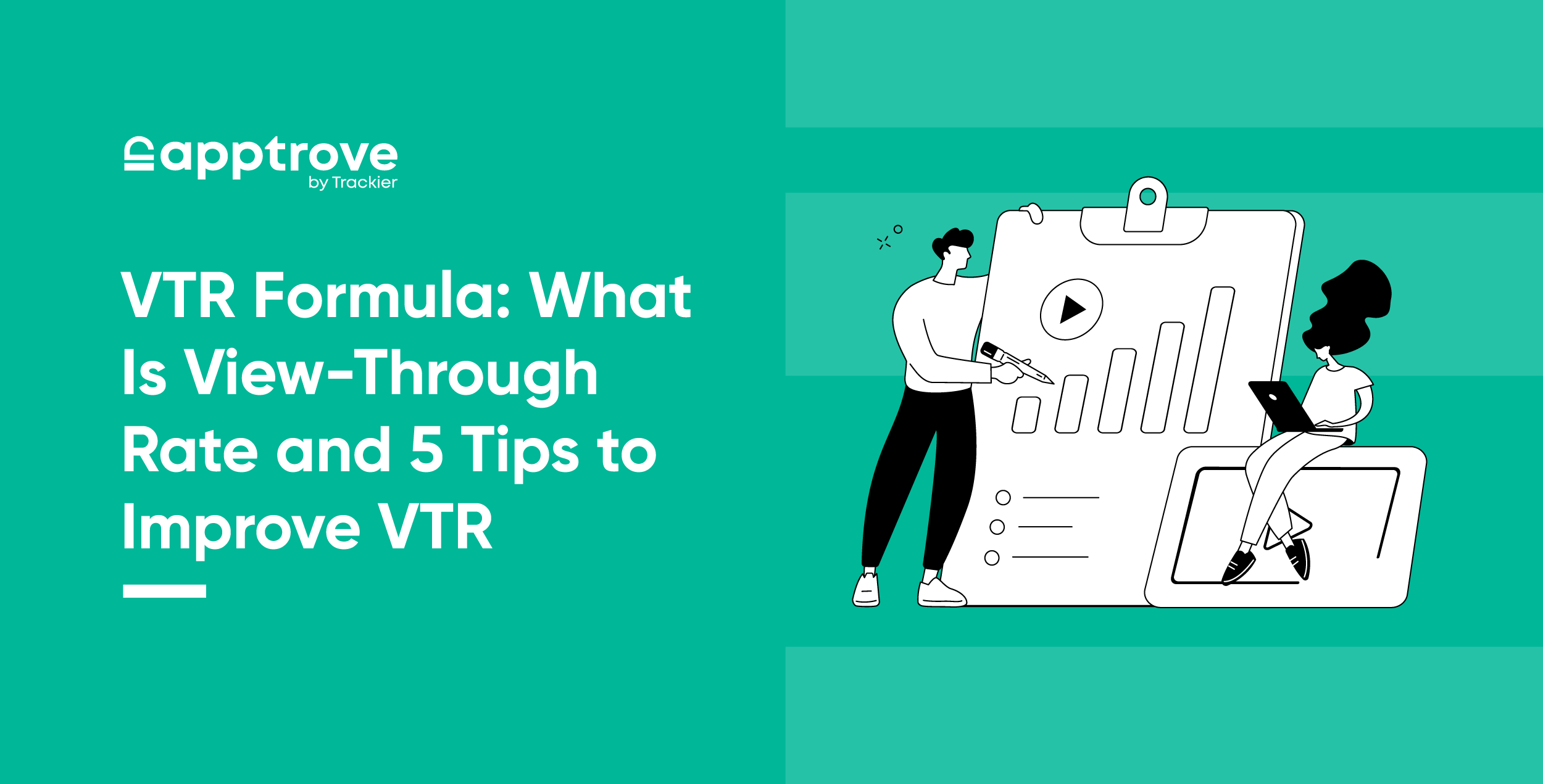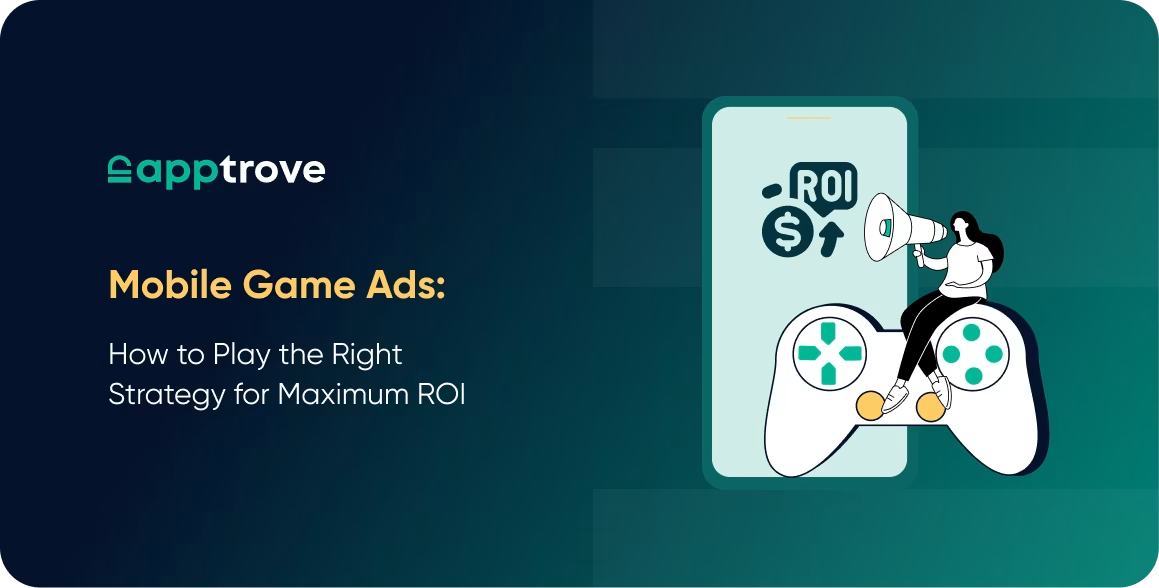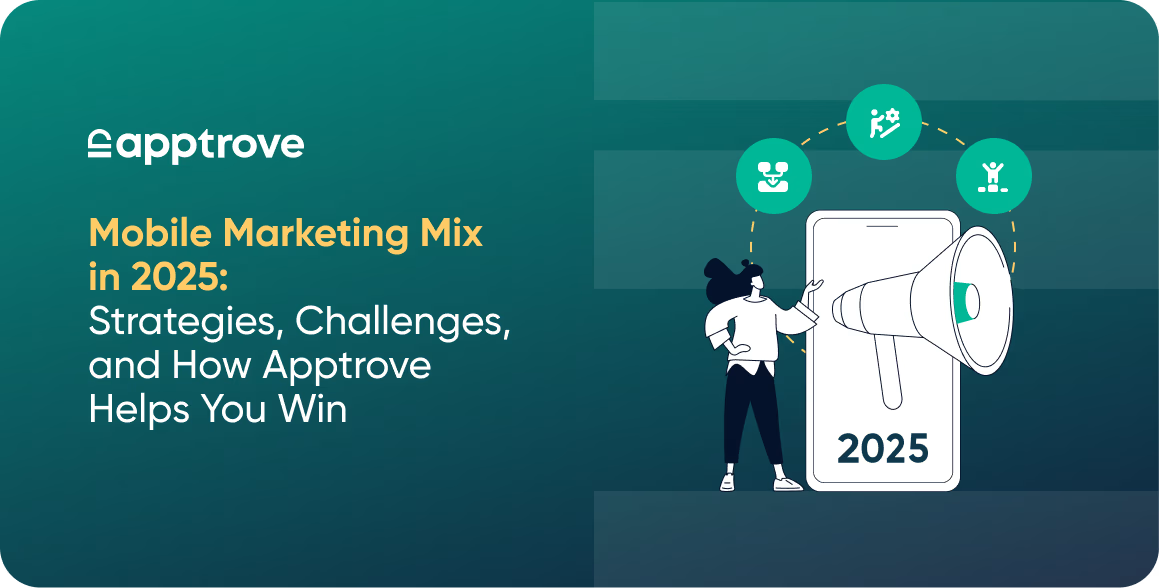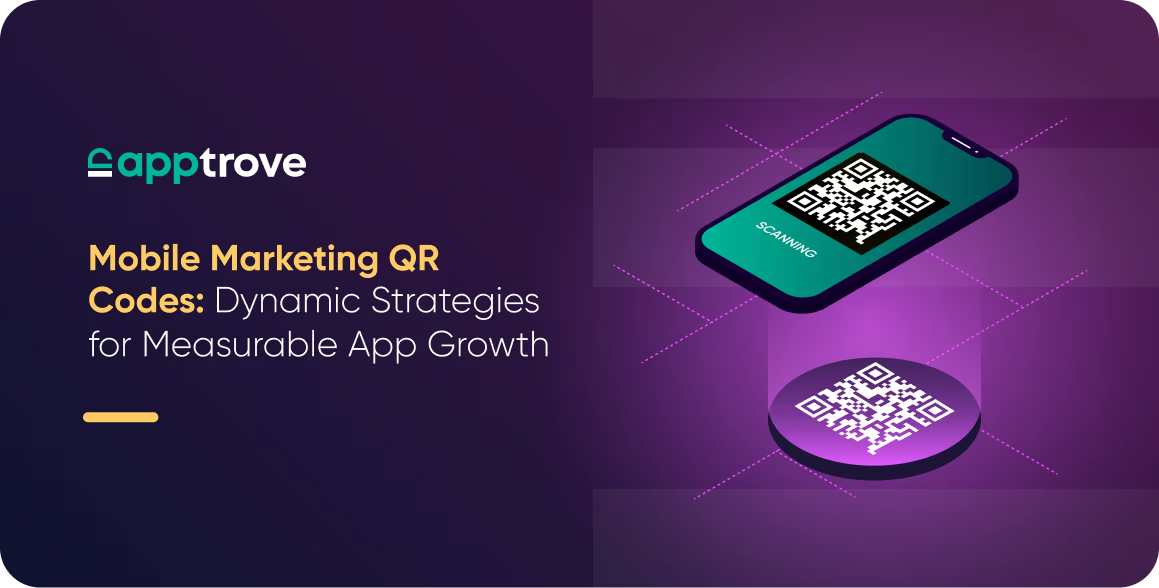From six-second clips to longer videos, video marketing captures attention like never before.
As digital viewership rises, marketers spend big on video ads—hitting $176.63 billion in 2023 alone.
If you aim to cut it in digital marketing, video ads can prove a game-changer.
But running ads alone isn’t enough, you must track the right performance metrics.
One key metric that often goes overlooked is the view-through rate (VTR), which measures the effectiveness of your video ad campaigns. It tracks how many users engage with your video ads without skipping.
A strong VTR means your ads are making an impact and driving conversions.
However, statistics reveal that around 66% of users skip in-app video ads when they can. Therefore, you need a smart strategy to improve your VTR.
In this post, we’ll explain the view-through rate, VTR formula, and its significance and share five actionable tips to help you get more from your video ads by improving VTR.
What Is VTR?
VTR full form is “View-through rate.” This metric measures the effectiveness of video ads by calculating the ratio of completed views of a skippable ad to its initial impressions (the number of times the ad is shown).
VTR reflects the number of users influenced to watch the entire video ad without skipping.
This metric is important because, even if viewers don’t take immediate action after watching, they may still be influenced to engage with your brand or product later.
View-Through Rate (VTR) Formula
Here’s the VTR formula.

Here’s a quick example to consider.
Say a company targeting mobile app users runs a skippable video ad on Facebook. Here are the metrics for that campaign:
- Total Impressions: 6,500
- Completed Views (Users Did Not Skip): 195
Now, applying the VTR formula:
VTR = (195/6500) x 100 =3%
A VTR of 3% means that out of all the mobile app users who saw the ad, only 3% watched it all the way through and got influenced. This suggests there’s very little engagement. So, the company needs to refine its ad content or targeting strategy to engage the mobile app users.
Factors Impacting VTR
Here are the key factors that can influence your VTR in digital marketing.
- Content: High-quality visuals can grab the audience’s eyeballs, encouraging them to watch until the end.
- Audience Targeting: Understanding the target audience thoroughly can lead to higher engagement and completion rates.
- First Impressions: The first few seconds of your ad are crucial. Viewers will likely skip it if it doesn’t capture their interest.
- Ad Length: Shorter ads can perform better than lengthy ones, as attention spans can wane quickly.
- Ad Placement: Ads in high-traffic areas or relevant content typically perform well.
Significance of VTR in Mobile Marketing
VTR helps identify how many users were influenced by a video ad.
With VTR, you can make informed decisions on video marketing budget allocation across different media sources. Besides, you can make strategic adjustments to improve ad viewership by gauging the audience’s behavior.
Benchmarks – What Does High or Low VTR Mean?
A VTR of 15% and above typically reflects a successful video ad. It states that an ad is making a meaningful impression on viewers.
Besides, it reflects increased brand awareness and a higher likelihood of users engaging with the mobile app or brand.
Does a higher VTR always mean a successful video ad?
Not necessarily.
While a high VTR is typically a positive sign, it doesn’t always equate to a successful video ad for every campaign. It depends on the key goal of the ad.
For instance, a gaming app might have a high VTR because of its engaging concept and visuals. However, if it doesn’t lead to the end goal of user acquisition or in-app purchases, the campaign’s ROI will be poor.
On the other hand, if the ad promotes premium gaming app subscriptions, a low VTR might still indicate a successful campaign. If only a few highly qualified users watch the video ad and then take action, the campaign can still deliver a strong ROI.
How Is It Different from VCR and CTR?
You might confuse VTR with VCR (Video Completion Rate) and CTR (Click-Through Rate). While all three metrics are crucial, they are not the same.
Here’s a quick table outlining the key differences between VCR, CTR, and VTR in digital marketing.
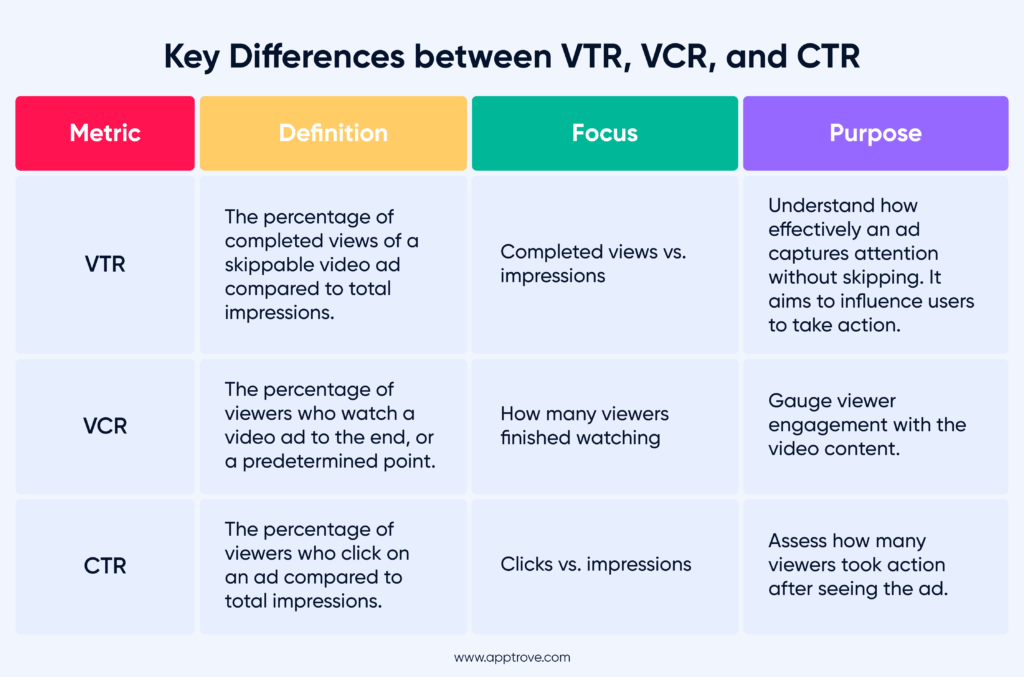
5 Tactics to Improve Your VTR
The VTR formula can help you calculate the effectiveness of your video ads. But first, you need the right strategies to maximize viewer engagement.
Here are the top five tactics to improve your VTR.
1. Engage the Audience with Effective Storytelling
A great story can draw in customers, keep them engaged, and encourage them to take action.
Start your story with a compelling hook that speaks directly to your target market challenges.
For instance, if you’re targeting a small e-commerce business, begin your video by sharing hard-hitting industry-specific statistics or addressing a common pain point. This will help you capture the viewers’ attention.
Next, quickly deliver value by showcasing how you can help them. Align with their interests by presenting relatable scenarios.
Add a CTA at the end to make your efforts fruitful. This can keep them hooked till the end while convincing the audience to take action.
Here’s a quick example of a 15-second storytelling video script to take some inspiration.
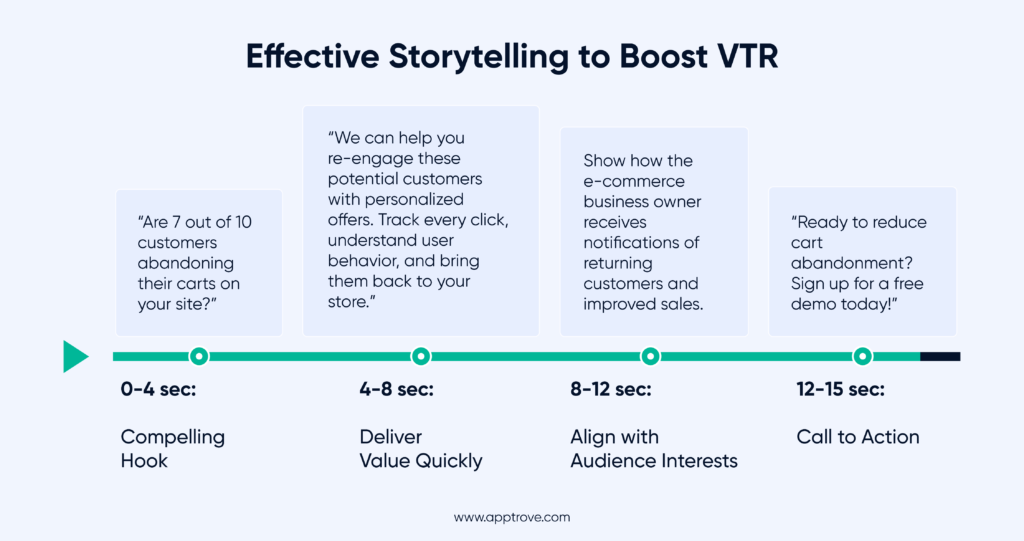
2. Prioritize Audience Targeting
Prioritize precise audience targeting to boost your ad’s impact.
Understand and analyze your target market. Research what kind of content they typically consume. This can help you choose the right ad topics and create tailored content.
Leverage tools like Google Search Console (GSC) to identify and analyze –
- What your audience is looking for
- The search terms they use
- Interests based on the types of queries
- Data on the countries or regions from which your organic traffic originates
Use this data to tailor your video ads and messaging to address specific interests.
For instance, if your target audience is financial services app marketers, you might discover they frequently search for solutions to reduce fraudulent installs. So, create a video highlighting robust fraud prevention features.
In addition to mobile ads, you can leverage CTV or OTT ads to target the same audience more effectively. Financial services brands could run fraud-prevention-themed video ads on popular OTT platforms during finance-related shows. This allows you to keep the audience engaged, thus boosting VTR.
What’s more? Try incorporating the audience’s feedback on your video ads. Run a poll and ask viewers to rate your ads.
Here’s a quick example.
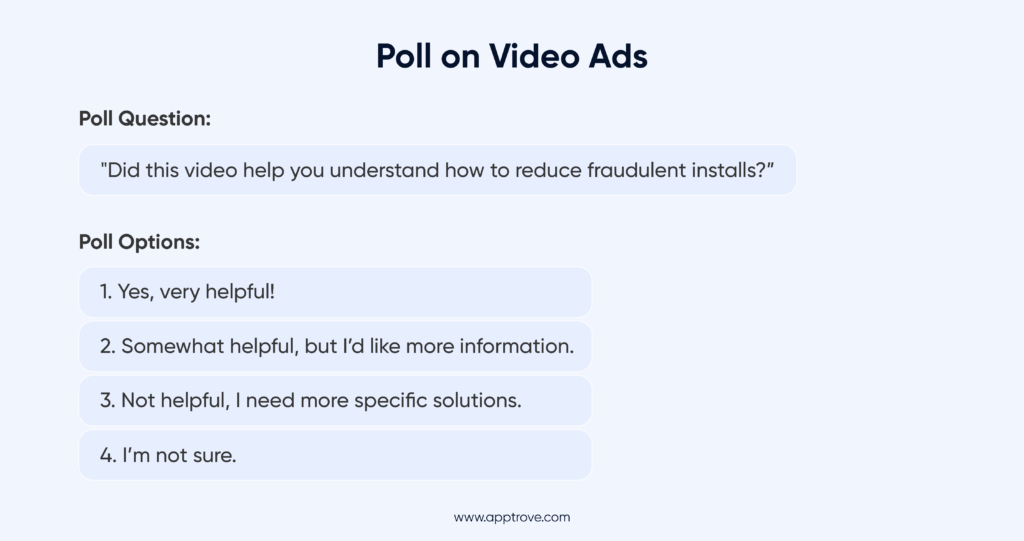
The responses allow you to gauge how well your video resonates with the target audience. This can drive higher engagement and improve VTR within no time.
3. Focus on the Video Ad Placement
Ad placements can influence how your audience interacts with your ads.
Place video ads in contexts where users are already engaged.
For instance, connected TV or CTV advertising on online streaming platforms often has good view-through rates. CTV viewers tend to be more engaged in long-form content, which reduces the chances of skipping ads. This contrasts with mobile platforms, where users are more prone to skip ads.
The right ad campaign at the right time and context can keep viewers invested throughout the ad, thus improving VTR.
4. Make Your Ads Skippable
Skippable ads give the audience a sense of control over their viewing experience.
Viewers can quickly judge whether the ad resonates with their interests. If it does, the chances of viewing increase.
Rather than forcing viewers to watch, capture their attention with exemplary content.
Here’s a quick hack —
Keep the ad crisp and short. Viewers are likely to view a 15-second ad rather than a 2-minute video.
For instance, create a skippable version introducing your offerings in the first 5 seconds. This gives users the option to skip if they’re not interested. However, those who like it will likely watch the entire content and take action.
5. Monitor Your Ad Performance
As a decision-maker, you must track users who take actions, such as downloading and actively using your app after viewing the video ads.
Monitoring your ad performance can help you optimize your strategies and achieve a high ROI in the long term.
How to do it?
Partnering with the right mobile measurement partner (MMP) can help you ensure accurate view-through attribution calculation.
MMP allows you to –
- Examine historical campaigns, past user behavior, and transactional data to predict future outcomes.
- Accurately track and attribute app installs and in-app user actions.
- Gain granular data that can help measure the effectiveness of ad campaigns and allocate the marketing budget to the best channel.
Simply put, MMP is your ideal companion to improve VTR by attributing, gathering, organizing, and tracking campaign data.
Pro Tip: Choose Apptrove to Enhance Your VTR
Our MMP software, Apptrove leverages next-gen technologies to help you get in-depth insights into user behavior and actions.
With Apptrove’s insights, you can swiftly track VTR, increase app installs, improve campaign ROI, boost user LTV, and optimize ad performance.
Here’s what we offer –
- Accurate Attribution: Our platform ensures precise attribution of app installs and user actions to specific ad campaigns. Our unified dashboard offers granular data about which ads lead to improved VTR and actual conversions, allowing for better optimization.
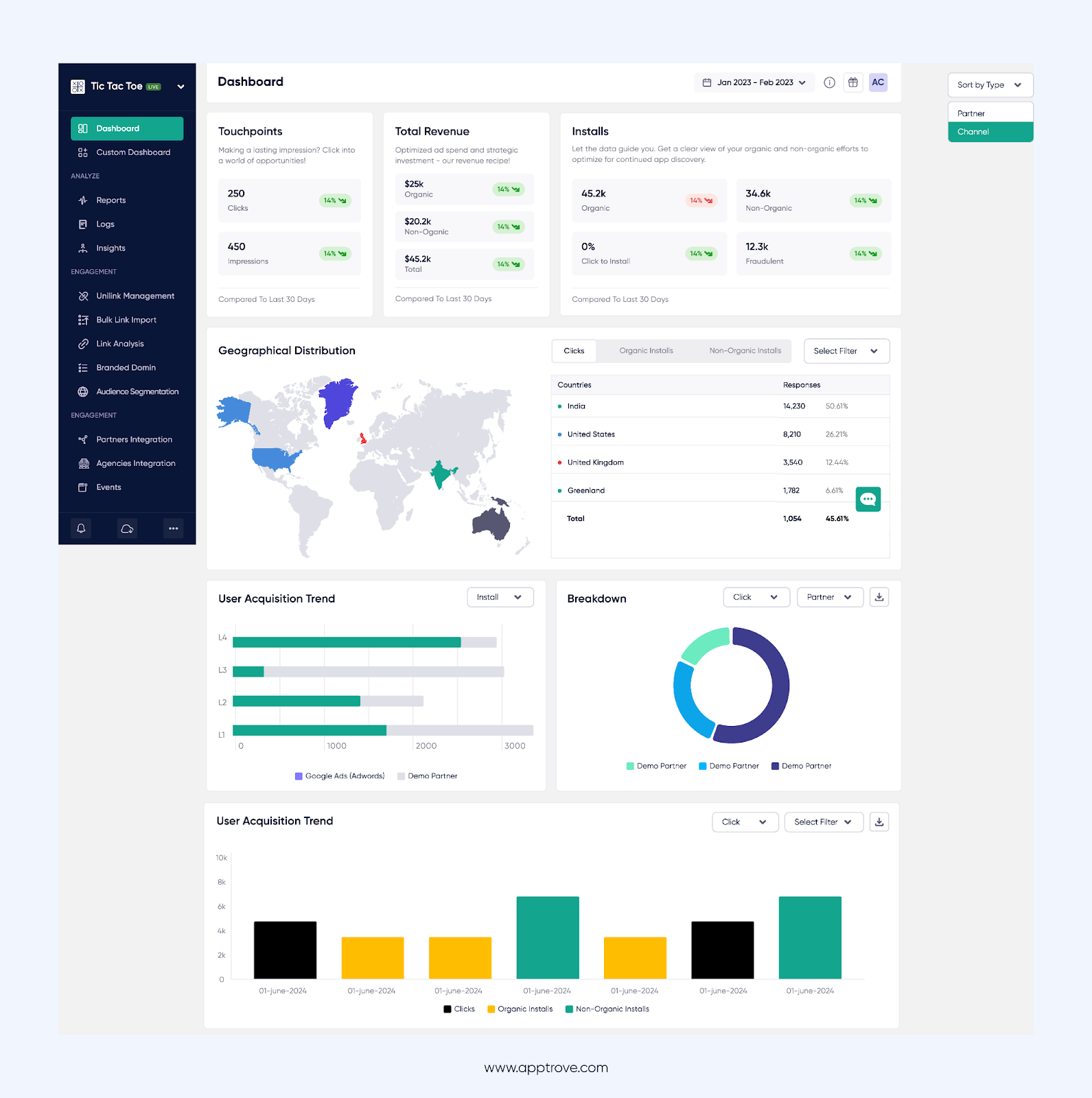
- Granular Analytics: Gain in-depth analytics that tracks VTR and breaks down user behavior post-install. Besides, Apptrove employs predictive analytics to forecast campaign performance. Our software helps you identify which video ads might resonate with your audience.
- Customizable Deep Linking: With Apptrove’s customizable deep linking capabilities, you can create personalized user journeys. This increases the chances of conversions by directing users to specific in-app content based on their interaction with your ads.
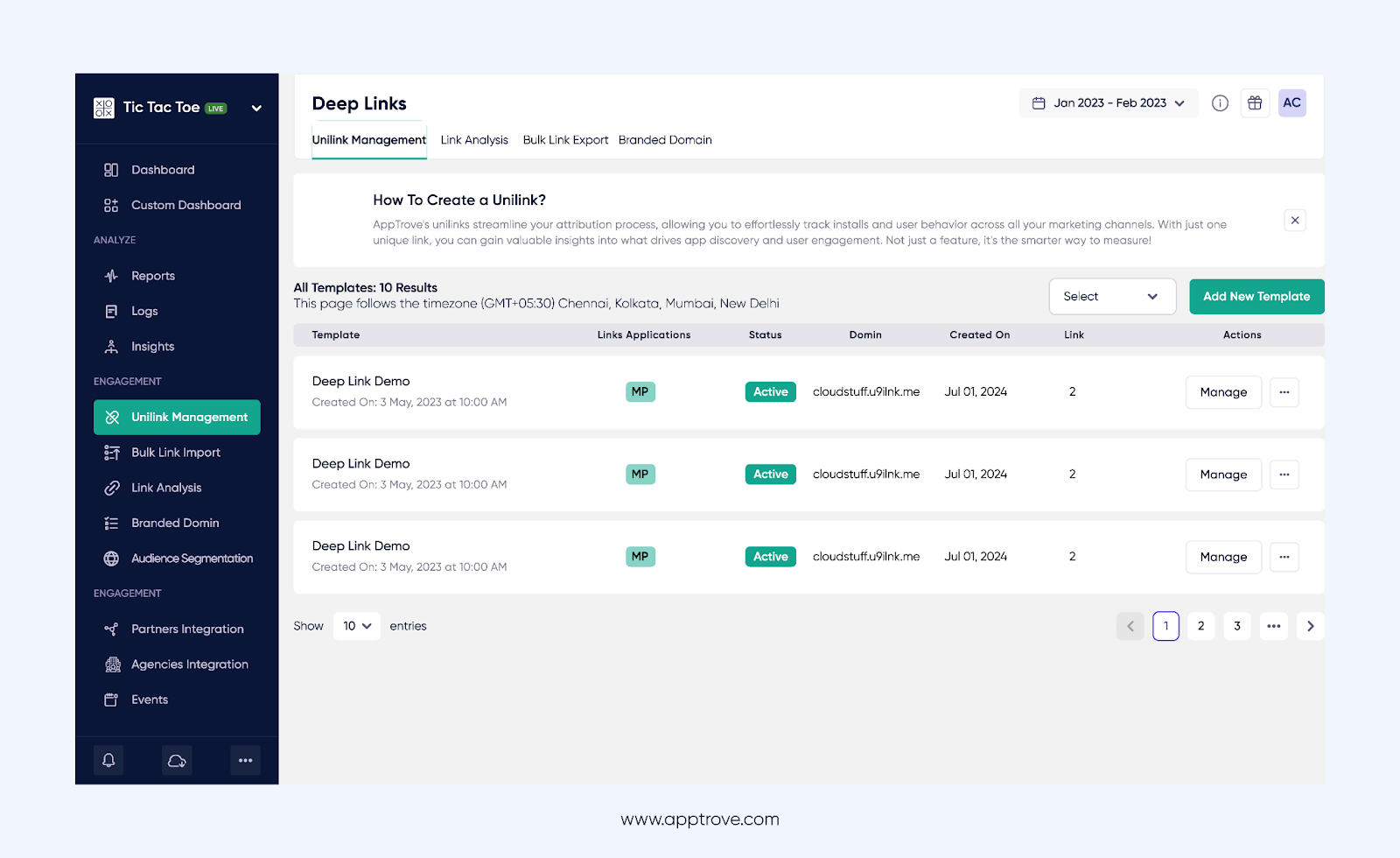
- Advanced Audience Segmentation: We offer sophisticated audience segmentation, where you can tailor campaigns to different user groups. Analyze who your most engaged users are and adjust your ad spend to target segments that yield higher VTR.
- Fraud Prevention Tools: With built-in fraud protection, AppTrove safeguards your campaigns against invalid traffic, ensuring that your VTR metrics reflect genuine user engagement. This leads to more accurate measurements and better resource allocation.
Summing Up
Often growth managers focus on metrics like video completion rate (VCR) and click-through Rate (CTR) and overlook view-through rate (VTR).
However, tracking VTR can prove a game-changer as it helps analyze whether your content resonates with the target market. Implement the strategies shared in this post to take your campaign performance to the next level.
Plus, with our best-in-class mobile measurement and analytics suite, Apptrove, your journey becomes hassle-free.
We’re here for you 24/7, ready to support you as you start your journey. Let’s take your ad campaigns to the next level together. Talk to our sales team now!
